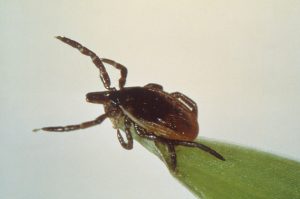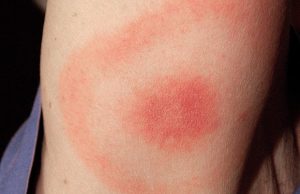The scientific name for Lyme disease is “Lyme Borreliosis.” It’s an infectious disease caused by a bite from a tick that is infected with the bacteria belonging to the “genus borellia.” So what’s the association between deer ticks and Lyme disease?

Adult Deer Tick
What Ticks Carry Lyme Disease?
While there are various types of ticks, not all of them carry Lyme disease. The only tick that is capable of infecting its bite victims with Lyme disease is the blacklegged tick. The blacklegged tick is often dubbed a “deer tick.” Its scientific name is “ixodes scapularis.” Even though its name seems to imply otherwise, not all deer carry the deer tick. Other types of ticks that are not carriers/transmitters of Lyme disease include:
- Lone star tick
- Rocky Mountain wood tick
- Gulf Coast tick
- Winter tick
- American dog tick
- Brown dog tick
The deer tick acquired its nickname because of its tendency to feed on the white-tailed deer as a host. The deer tick will sometimes use other larger mammals to feed on – humans included. Humans are most often considered to be accidental hosts of the deer tick. When bitten, these individuals are highly at risk to contracting Lyme disease. Other larger mammals that deer ticks will munch on include domestic pets and/or livestock and are located primarily in the eastern part of the United States.
Most ticks will hide in or around the living space of their hosts whenever they’re not actively feeding on them. Humans will sometimes encounter these ticks because their animal hosts unintentionally will bring the ticks inside the home. The majority of ticks prefer forested, high grass, brush, deserts, woodpile areas and around beaches. The deer tick is usually most active when the weather is warm, above 45 degrees Fahrenheit.
Deer ticks are not born infected with the Lyme disease bacterium. A deer tick larvae will have to feed on an infected host in order to become infected with the bacterium that causes Lyme disease. Infected deer ticks that are in either their nymph or adult stage of their life cycle are the only ticks capable of infecting a human with the disease. The disease is more likely to be transmitted from the bite of a tick that is in the nymph stage because they are smaller in size. Adult ticks are usually noticed and removed from the body before they have a chance to infect a human host.
Symptoms of Lyme Disease
The symptoms of Lyme disease can differ based on the stage of the infection. The first and earliest stages of Lyme disease symptoms occur between Day 3 and Day 30 after a human has been bitten by an infected tick.
- A red rash that gradually expands called “erythema migrans” (also called “EM”)
- Fever, fatigue, chills, headache, joint and muscle aches, swollen lymph nodes
- A small bump and/or redness at bite site that disappears in 1-2 days, similar to a mosquito bite
The EM rash occurs in approximately 70-80% of those infected. It begins at the bite site after about 3-30 days (the average is around 7 days). The EM rash will gradually expand over several days, and can grow to be as long as 12 inches (30 cm) across. Some areas of the rash can clear up as it spreads and can resemble the appearances of a “bull’s-eye.”

Lyme Rash
The EM rash is usually warm to the touch. However, it’s rarely itchy and painful. EM lesions can appear anywhere on the body.
If the infection is left untreated, it may spread from the bite site to other areas of the body and produce a range of specific symptoms that can come and go:
- More EM lesions on other areas of the body
- Loss of muscle control on one or both sides of face (Facial or Bell’s palsy)
- Severe headaches and stiff neck from meningitis (inflammation of spinal cord)
- Pain and swelling of large joints (i.e. knees)
- Shooting pains that may interfere with sleep
- Heart palpitations and dizziness due to changes in heartbeat
How Lyme Disease Can Be Prevented
You can prevent contact with infected ticks by:
- Avoiding bushy and wooded areas with high grass and/or leaf litter
- Repelling ticks with DEET or Permethrin
- Using tick repellents with 20 to 30% DEET (N, N-diethyl-m-toluamide) on skin and clothing
- Using products that contain permethrin on clothing
- Wearing pre-treated clothing that is available and may protect you longer
- Finding and remove any ticks that are on your body
- Doing a full-body tick check upon return from tick-infested areas
- Inspecting gear and pets
- Placing clothes in dryer on high heat for 1 hour to kill any remaining ticks

No Comments